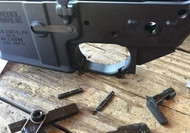Short Shot
Posted by Richard Mann on Oct 31st 2017
(The following is an article from Buckmasters GunHunter's July 2007 issue.)
For years, it has been fashionable to blame lawyers for the heavy, creepy or rough triggers that come on factory rifles. Lawyers get blamed for a lot of things they may or may not deserve. but bad triggers are more the result of high manufacturing costs than from litigation.
Building a good trigger is expensive, adding as much as 25 percent to the cost of some bargain-priced hunting rifles. Firearms manufacturers have found that they can sell guns with heavy triggers because consumers will either accept a gritty go-switch, have a gunsmith tune it. or replace the factory trigger with an aftermarket product.
If you're like most hunters, you just accept the trigger that came with your rifle. Using a heavy trigger with a lot of creep or overtravel might be a good excuse for missing a big buck, but it doesn't say much about one's common sense.
Some shooters think the only path to a good trigger is through a good gunsmith. Triggers can be safely improved by talented gunsmiths, but it's been my experience that up to half of all worked triggers can be unsafe. The other option is to install an aftermarket trigger yourself. I avoided this option for a long time because I imagined it would be difficult Boy, was I wrong.
Timney, by the way. has been building modular replacement triggers for over 60 years. The company offers triggers for most of the popular bolt-action rifles on the market, and in some cases, as with the Remington Model 700, several different trigger models are available.
I recently watched John Vehr of Timney Triggers install a trigger with an integral safety in a Model 700 rifle. The entire process took just less than 16 minutes, and John was fielding questions and explaining the process as he worked.
Not all of us have a Remington 700 rifle, and installing triggers on other actions can more difficult, sometimes requiring the removal of a small amount of stock material. Other triggers, like the replacement model for the Weatherby Vanguard, are much easier to install. In most cases, swapping a factory trigger for a crisper aftermarket product is a fairly simple process that requires only a few tools.
In the limited space here, I cannot cover trigger installation in every type of rifle, but I can describe the process in the Model 700, one of the most popular hunting rifles ever manufactured. For the most part, the process is very similar with other rifles. Whichever rifle model you have, it's a good idea to secure it in some type of gun vise that will hold the action steady.
The first step to working on any rifle is always to check and make sure it is unloaded. Riflescope removal is optional, but you must take out the action from the stock. This is accomplished by removing the front and rear action screws.
The trigger on the Remington 700 is held in place with just I can be driven out with a punch and hammer, pushing the pin from the right to the left side of the action. Note that the rear pin that holds the trigger assembly also secures the bolt stop on the left side of the action. Take care not to drive this pin all the way out. This greatly simplifies installation. Let it remain the action just far enough to hold the bolt stop and spring in place. After the front pin has been driven out, the trigger assembly will drop from the action. At this point, insert the new trigger unit into the action so it lines up with the pin holes. Now drive both pins back through so that they are flush on both sides of the action.
Now you should check to make sure that trigger will function. Dry-fire the rifle several limes, working the bolt as you normally would, to make sure the trigger is operational and won’t accidentally misfire.
Like the Remington Model 700 rifle trigger it replaces, Timney triggers come with three adjustments, sear engagement, overtravel and pull weight. These screws have lock nuts attached to secure the setting from the factory. Timney triggers are properly tuned to offer about 2.75 pounds of resistance. The sear engagement and overtravel screws are preset as well. Every trigger Timney produces is installed and tested on a n individual rifle prior to shipment.
It’s tempting to use Lock-Tile to secure the settings, but Timney discourages it, along with oiling the trigger assembly. If you must lubricate it, squirt a small amount of lighter fluid into the trigger mechanism.
All that’s left is reattaching the stock to the action.
For most bolt-action rifles, you will not need to drill, tap or alter any metal parts or surfaces because the replacement trigger is a true “drop-in” unit. If you have any doubts about your ability to replace the trigger on your rifles, you can always take it to a gunsmith and have him to do the work. Another option is to ship the rifle to Timney. They will install a trigger for a nominal fee and return the rifle to you. The turnaround time is usually about two weeks.
Regardless of how well your refile is built. How good your optics are or the quality of your ammunition, without a crisp trigger that offer consistent function, you will never realize the maximum potential of your rifle or your true shooting ability. It’s satisfying to cure this problem at home and all on your own.

